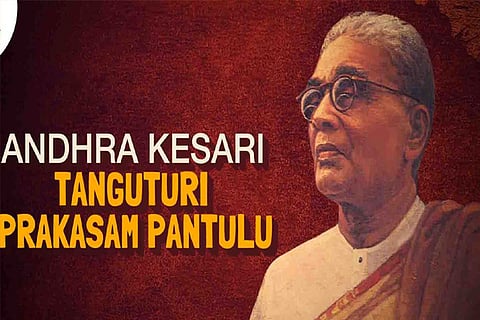

Chennai
Time magazine had once parodied him: “Old Tanguturi Prakasam, the head of the southern province of Madras, has some strange ideas. He would, for example, like to scrap Madras’s big textile industry in favour of Mohandas Gandhi’s cottage spinners…” That shows the extent to which Gandhian Tanguturi Prakasam Pantulu, known as the lion of Andhra and a chief minister of two states, would go in implementing what he believed in.
As a child in Andhra, he was drawn to the stage and mainly did the ‘stree’ part — the heroine’s role. However, he had in his opposite house a lawyer whose shiny black coat inspired him. That small desire pushed him towards the legal profession. Though interested in practising law, Prakasam was poor in academics and the best he could do after moving to Madras was to become a second-grade pleader. He could not argue cases at higher courts, and obsessed with this shortfall, he decided to go to England to pursue legal studies. There were two hurdles, money for the travel and an orthodox mother, but he overcame both.
Prakasam went on to become one of the most successful lawyers in Madras for 14 years during when he was earning a princely average of Rs 7,000. However, the courts were the hotbed of freedom politics and Prakasam was no exception. Inspired by Bipin Chandra Pal’s speeches, he gave up his legal practice and later took the satyagraha pledge.
Prakasam wanted the satyagraha ideals to reach the common man and felt the press was the strongest tool against the ruling British as well as Annie Besant’s New India. He started a newspaper Swarajya (meaning self-rule) in English, Telugu and Tamil. Prakasam was too much of an idealist and much less a businessman and with these papers lost his earnings, savings and assets trying to keep them afloat. Finally, one by one, the papers shut down (even when the employees offered to work for free). But there was a good collateral effect. Prakasam moved into active politics from the sidelines that he was stationed in.
The docile satyagrahi was literally lionized because of one incident. Opposing the Simon Commission, demonstrators had gathered on China Bazaar and when a demonstrator was shot and his corpse lying untended on the road, the police warned that another step forward by anybody else would mean a bullet in his ribs. Prakasam undid his shirt buttons, bared his chest as a challenge and moved forward to retrieve the martyr’s body. The soldiers’ threat turned out to be empty. Prakasam’s brave deed that day was noticed and remembered for long. Soon thereafter he was christened Andhra Kesari and the road where he performed this supreme deed is still called Prakasam Road.
When the Mahatma announced his Dandi March, the Madras Presidency Congress unilaterally decided on the venue of distant Vedaranyam. Many leaders like Prakasam differed and the Andhra Provincial Congress Committee opted to conduct the Satyagraha at the Marina beach in Madras. The selected volunteers started the march from the house of Prakasam and he took the lead in picking up the salt lying on the seashore.
Irked by this, the Madras Police reacted by resorting to lathicharge on the volunteers. Prakasam and other senior leaders got arrested and this triggered an unscheduled hartal when the policemen shot to kill. On the same day, the police, in punitive action, seized the properties of Prakasam. Historians would agree that though the Vedaranyam march of Rajaji gobbled eyeball space, the Madras march led by Prakasam politically solidified the Telugu speaking politicians of Madras Presidency.
Soon freedom was on the horizon and elections were held in 1946 and there was a race on who would lead the Presidency to freedom. The Congress won easily but it was only the beginning of the problems. Gandhi and the Congress Working Committee wanted Rajaji back at the helm (Rajaji with other chief ministers had resigned in the late thirties in response to Gandhi’s call.)
The linguistic and caste differences amongst the elected legislators came to the fore. The seeds for the linguistic division of states had been sown even when the Marina salt march was about to bear fruit. When it was evident that Telugu speaking legislators outnumbered the rest, it was obvious Prakasam would be the choice. He was elected but this angered many in the higher echelons of the Congress.
When questioned on how his ministry would function, Prakasam said that’s for time to see but his immediate role was to release all political prisoners languishing in jail and refund punitive fines the British government had imposed on individual and towns during the Quit India Movement.
The ban on Bharathi’s poems and hoisting of Tricolour was rescinded. Lifting the ban on Radhika Santawanam, the first book banned for vulgarity, he boasted: “I am restoring a few pearls to the necklace of Telugu literature.” A Gandhian in totality, Prakasam publicly declared his government’s intention to scrap all existing textile mills in the Presidency. Unfortunately, regionalism and petty politics reared its head and it was not Prakasam who led the Presidency to freedom. His government lasted for only 11 months. Not only was Prakasam asked to resign his post but Gandhi, whom he revered, wrote to him asking him to resign from the Congress party as well. Prakasam would spend time in the political wilderness till Andhra state was formed and he was asked to be its chief minister.
The giant of a man, Prakasam is remembered with a nine-foot statue in Parliament and one near Broadway where he performed the heroic act of defying anarchy.
— The author is a historian
Visit news.dtnext.in to explore our interactive epaper!
Download the DT Next app for more exciting features!
Click here for iOS
Click here for Android